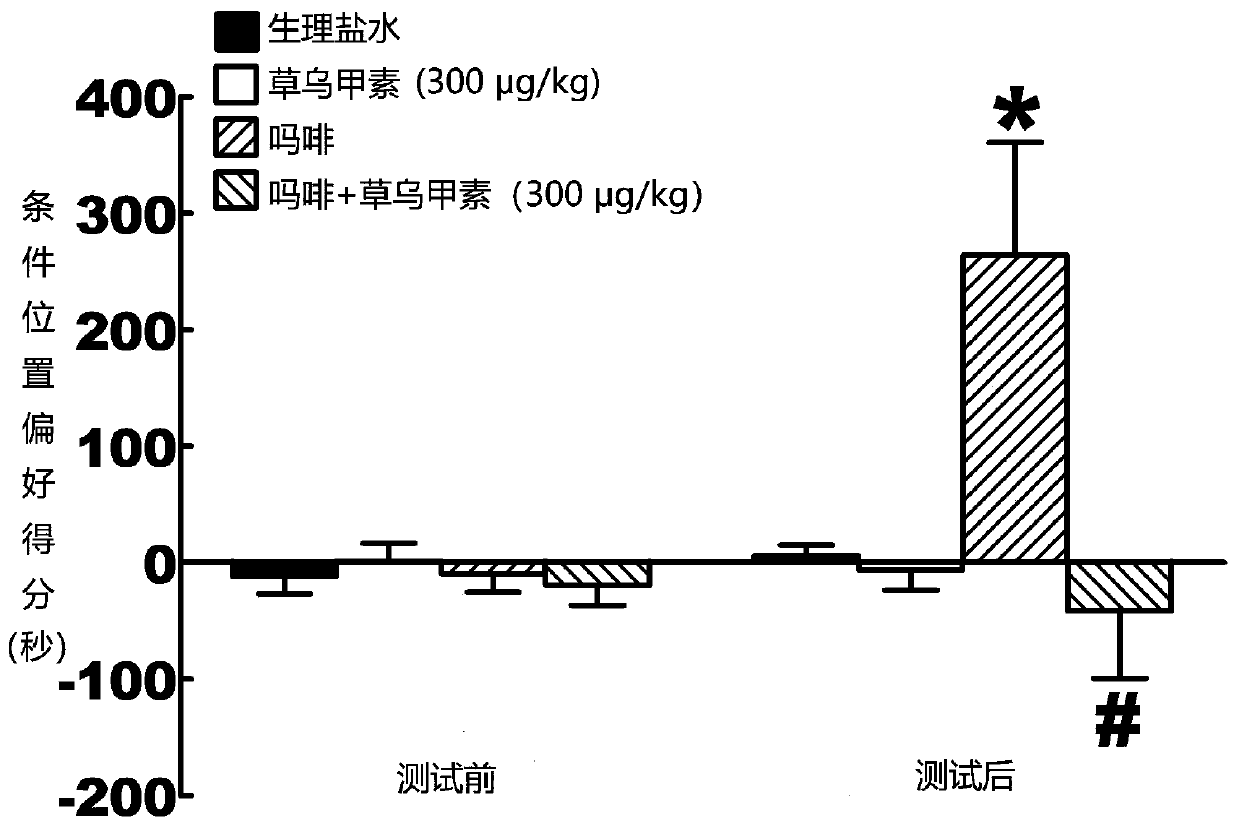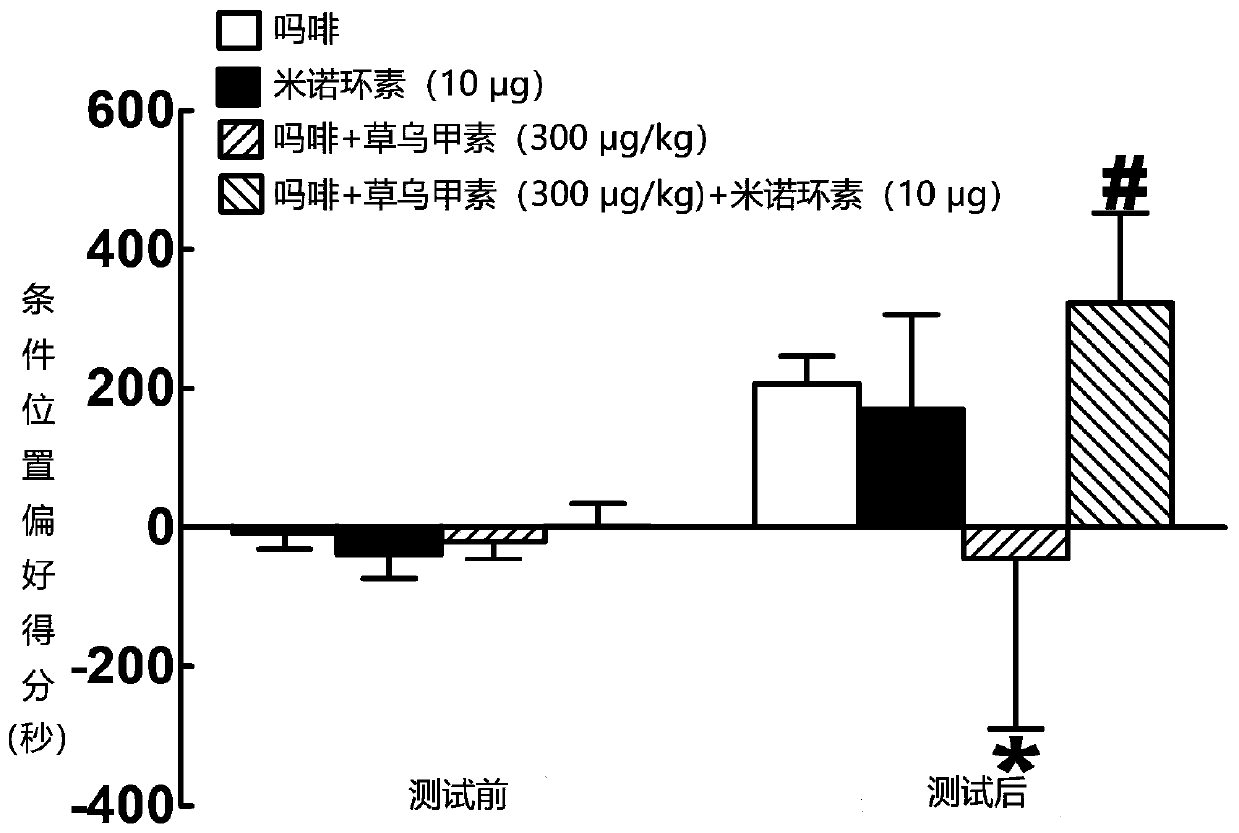Use of lannaconitine compound to treat psychological dependence of addictive substances
A technology of addictive substances, clathrate, applied in the field of medicine, can solve the problems of mental dependence, repeated use, and craving for addictive substances that cannot be reduced in addicted objects.
- Summary
- Abstract
- Description
- Claims
- Application Information
AI Technical Summary
Problems solved by technology
Method used
Image
Examples
Embodiment 1
[0088] Example 1 Single subcutaneous injection of aconitin (BAA) effectively alleviates the effect of morphine-induced conditioned place preference in mice
[0089] Male Kunming mice (body weight 18-22g), the animals acclimated to the environment for 3 days, and then touched the mice for 3 days, twice a day, each for 2 minutes, to facilitate subsequent administration. The mice were randomly divided into four groups, namely the normal saline group, the morphine tolerance group, the aconitine group (300 μg / kg) and the morphine tolerance + aconitine (300 μg / kg) group, with 10 mice in each group.
[0090] Establishment of conditional place preference: The experiment was conducted for a total of 6 days.
[0091] On the 0th day, the four groups of mice were put into the three boxes of conditional position preference, and the baffles were removed, and they were allowed to shuttle freely for 15 minutes. The residence time of the mice in the black box and the striped box was recorded, ...
Embodiment 2
[0096] Example 2 Injection of the selective κ-opioid receptor antagonist GNTI into the lateral ventricle reverses the effect of aconitin against morphine-induced conditioned place preference in mice
[0097] The establishment method of morphine-induced conditioned place preference is basically the same as in Example 1, except that the type, dosage and method of administration to mice in each group are as described in this example. The experiment was divided into 4 groups, namely morphine tolerance group, morphine tolerance + GNTI group, morphine tolerance + aconitine (300 μg / kg) treatment group and morphine tolerance + aconitine (300 μg / kg) +GNTI group, 10 rats in each group.
[0098] On the second day after the conditional position preference was established, the four groups of mice were subjected to lateral ventricle intubation, which was the same as in Example 2: lateral ventricle intubation: male Kunming mice (body weight 18-22 g), animals adapted to the environment 3 sky...
Embodiment 3
[0100] Example 3 Injection of dynorphin antiserum into the lateral ventricle reverses the effect of aconitin on conditioned place preference induced by morphine in mice
[0101] The establishment method of morphine-induced conditioned place preference is basically the same as in Example 1, except that the type, dosage and method of administration to mice in each group are as described in this example. The experiment was divided into 4 groups, namely morphine tolerance group, morphine tolerance + dynorphin antiserum group, morphine tolerance + aconitine (300 μg / kg) treatment group, morphine tolerance + aconitin ( 300 μg / kg) + dynorphin antiserum group, 10 rats in each group.
[0102] On the second day after the conditioned place preference was established, four groups of mice underwent lateral ventricle intubation, and the lateral ventricle intubation was the same as in Example 2. On the 6th day when the conditioned place preference was established, at 8:00 in the morning, the...
PUM
 Login to View More
Login to View More Abstract
Description
Claims
Application Information
 Login to View More
Login to View More - R&D
- Intellectual Property
- Life Sciences
- Materials
- Tech Scout
- Unparalleled Data Quality
- Higher Quality Content
- 60% Fewer Hallucinations
Browse by: Latest US Patents, China's latest patents, Technical Efficacy Thesaurus, Application Domain, Technology Topic, Popular Technical Reports.
© 2025 PatSnap. All rights reserved.Legal|Privacy policy|Modern Slavery Act Transparency Statement|Sitemap|About US| Contact US: help@patsnap.com



